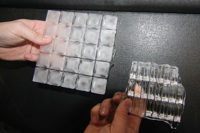
Figure
1. A cutting edge, or flight, is shown to the right in this photo of an auger.
(Courtesy of Ferris State University.)
Many ice flake machines employ an auger rotating within an insulated freezing cylinder or evaporator. The auger, which is driven and geared down by a gear motor and gear box to about 8-16 rpm, has cutting edges or flights. The flights shave ice from the walls of the freezing cylinder (evaporator) which is flooded with water and has refrigerant lines wrapped around its outer circumference (Figure 1). The refrigerant lines have vaporizing refrigerant in them which will freeze the water that is in close proximity or contact to the inside of the freezing cylinder.

Figure
2. This schematic shows the relationship of the water level with the freezing
cylinder in a flake ice machine. (Courtesy of Hoshizaki America.)
Because water will seek its own level, the water level or height in the water reservoir will also be the level in the freezing cylinder (Figure 2). Water level in the reservoir is usually controlled by a single float mechanism, or a dual-float mechanism which controls an electric solenoid valve to bring water to the reservoir.
The water-logged shaved ice is then carried through the water to the top or head of the freezing cylinder where it is squeezed, extruded, shaped, cut and eventually falls to an insulated ice storage bin for use (Figure 3).
It is of utmost importance that the water level in the reservoir and freezing cylinder are at the proper levels for the ice flake machine to operate effectively. What follows are some scenarios for improper water levels in the freezing cylinder, and how they affect other components of the ice flake machine.
LOW WATER LEVELS
If a float mechanism in the water reservoir is adjusted wrong and the water level is low in the reservoir, it will also be low in the freezing cylinder because of water seeking its own level. Since water is the refrigerating load for an ice flake machine, low water level in the freezing cylinder means low load on the evaporator. This condition will cause lower than usual evaporator pressures, thus lower evaporator temperatures.These low evaporator temperatures will produce harder and colder ice for the auger to cut. This will put an extra load on the auger, gears, and gear motor. Often, the gear motor will trip on its overload and sometimes has to be manually reset. Water reservoirs should have a line indicating the correct water level for that particular machine.

Figure
3. Water-logged shaved ice is carried through the water to the top or head of
the freezing cylinder where it is squeezed, extruded, shaped, cut and
eventually falls to an insulated ice storage bin for use. (Courtesy of Ferris
State University.)
HIGH WATER LEVELS
If the float mechanism in the water reservoir is adjusted wrong, or the seat in the float chamber is leaking and the water level is too high, the freezing cylinder will experience high water levels. This will cause stress on the gear motor from the auger doing more work because there is more surface area of ice to cut.Again, the overload may trip on the gear motor. When the gear motor’s overload reset button must be reset often, a service technician should suspect water level problems as a possible cause. Often, high water levels will cause water to pour over into the ice storage bin and cause a large melting depression in the stored flaked ice. Also, this new water constantly coming into the freezing cylinder will impose extra heat load on the evaporator and cause higher than normal evaporating pressures and poor ice quality and quantity. This happens because the higher quantities of new water will have to be refrigerated to the freezing point to start making ice.
Publication date:02/07/2011









